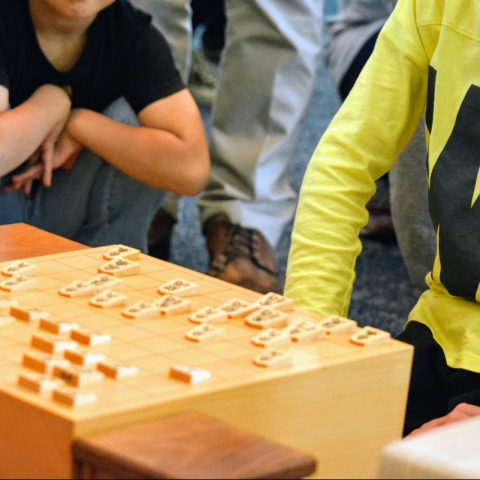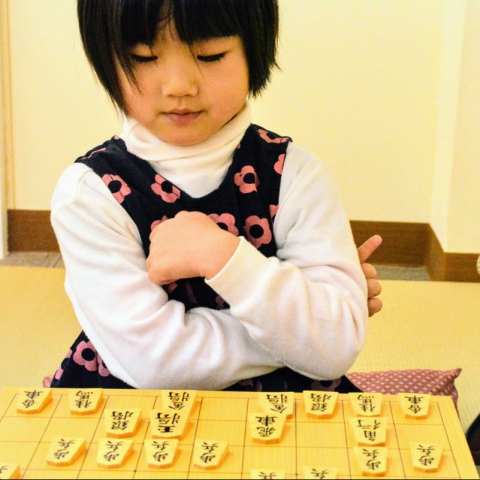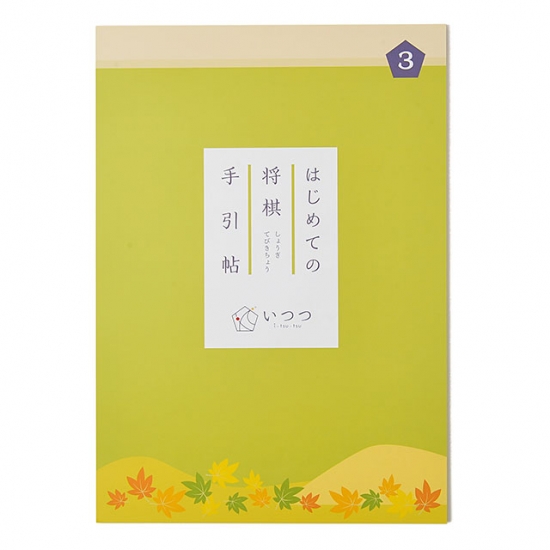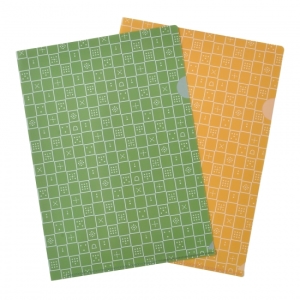Books
Shogi Lesson Book for Beginners Vol. 3
1,500 (JPY)
Product Description
A series of Introductory Shogi Textbooks, “Shogi Lesson Book for Beginners Vol. 3” is now available. This series is aimed to make it possible for children who have no experience in Shogi to enjoy learning Shogi.
This book gives you very fundamental and necessary information about Shogi, such as “What Shogi is” or “What piece moves are”, so that both small children and their mothers who are totally unfamiliar with Shogi can enjoy learning to play Shogi.
After learning “the moves of pieces and basic Shogi rules” in “Shogi Lesson Book for Beginners Vol. 1” and “basic techniques to play Shogi” in “Shogi Lesson Book for Beginners Vol. 2”, let’s go to the next step with “Shogi Lesson Book for Beginners Vol. 3”. You will learn basic Shogi strategies and ideal piece-buildings in the opening game through “Shogi Lesson Book for Beginners Vol. 3”.
“Basic Shogi strategies” is one of big challenges for children who are beginners in Shogi to reach the level which requires them to enjoy a Shogi game while thinking moves. Contents of learning in “Shogi Lesson Book for Beginners Vol. 3” is much more challenging than those of the previous 2 textbooks, “Shogi Lesson Book for Beginners Vol. 1” and “Shogi Lesson Book for Beginners Vol. 2”. So, not only Ms. Akiko Nakakura, a ladies professional Shogi player, but many Shogi instructors often rack their brains about how to teach them.
Therefore, we made all kinds of effort to make “Shogi Lesson Book for Beginners Vol. 3” not to be something puzzling or extremely difficult.
4 Recommended Features of, “Shogi Lesson Book for Beginners Vol. 3”
Feature #1: Keep Children from Memorizing Whole Things
Children are going to learn “Joseki” in “Shogi Lesson Book for Beginners Vol. 3”. “Joseki” means standard move sequences that are thought to be the most effective. Usually to remember “Joseki”, you are encouraged to memorize entire move sequences. However, in “Shogi Lesson Book for Beginners Vol. 3”, we deliberately keep children from memorizing “Joseki” as it is.
Letting children not to memorize whole move sequences with Shogi notation, which indicates the location of each piece on a board, we explain an aim and grounds for making each move.
We had always conducted studies targeted at our users, before we made a series of “Shogi Lesson Book for Beginners”. Based on valuable feedbacks from children and their parents, through trial and error processes, we accomplished to make textbooks. The most common feedback from the study conducted for “Shogi Lesson Book for Beginners Vol. 3” is “What if the opponent won’t follow Joseki?”. In that sense, if you merely memorize whole orders of “Joseki” as your tactics, such tactics couldn’t be applied to the real game situations. On the contrary, when you have concrete understanding about the logic of making each move, that knowledge will help you make the best move against the opponent’s unexpected move.
Feature #2: Carefully Selected Materials That Can Be Used in A Real Game
You will learn about Kakoi, or castle, in “Shogi Lesson Book for Beginners Vol. 3”. Kakoi is a partial piece formation, which is like a castle and built during the beginning of a game. The beginning of a game is considered as a period of preparing for attack. Gathering pieces, such as Kin, Gin, Kei, or Kyo, around Gyoku to build up a barricade to protect your Gyoku.
For those who know Shogi very well, it’s well known that there are several Kakoi; some of them have cute names, such as a crab castle or a strawberry castle and others have nifty names, such as “Kin Musou” (two pieces of Kin standing next to each other) or “Tenshukaku (castle tower) Mino”. If you could build them by following a simple procedure, it wouldn’t bother you a lot. However, things are not that simple. Some Kakoi require you to take several dozens of moves to complete building up a castle. For children who are new to Shogi, it’s quite difficult or even unrealistic to remember all series of moves for all kinds of Kakoi.
In “Shogi Lesson Book for Beginners Vol. 3”, we are focusing on only four kinds of Kakoi that are practical and easy to use for children.
If you know more kinds of Kakoi than others do, that would be great. But, without knowing all kinds of Kakoi, you surely can enjoy playing a game.
Feature #3: Questions Reflecting Lesson Contents
One of criteria to evaluate the value of textbooks is the quality of questions provided; “How meaningful are questions?” This asking is not only for Shogi textbooks, but for any subjects. We think this is very important point to be examined. And this asking could be comparable to the one; “How clear and simple are provided explanations?”
Where does our this awareness come from? Even children are provided with detailed and clear explanations, they might not be able to attain thinking power which can be applied to more complicated situations by being tested with easy questions that ask just contents of explanations. On the other hand, if the following questions are way too difficult, children may lose their self-confidence and motivations. This will happen, because children find no clue how to solve the questions and they can’t think them good challenge.
Those who create questions have to make sure that questions are fair enough for children; they are not too difficult nor too easy. Those questions should be somethings that children can get the answer for after good considerations. As to the contents of Shogi textbooks, setting level of difficulty is quite challenging. For example, this level could differ very much according to the difference in number or locations of pieces.
When making “Shogi Lesson Book for Beginners Vol. 3”, this issue was a pain in the neck for us.

While I and staff members were continuing the process of trial and error, we couldn’t receive positive feedbacks from targeted users. To tell the truth, once I came very close to giving up this project. Fortunately, I had a reliable helper. His name is Mr. Takashi Araki who is a instructor of our Shogi class and a former member of Shoureikai.
Shoireikai is the training organization of Japan Shogi Association where the young who are aspiring Shogi professional players are in fierce competition to sharpen their skills in Shogi. He has considerable experience in such circumstances where he played thousands of tough games. Giving me great ideas, He helped me a lot in replicating situations that focus on practice.
Therefore, I definitely claim that “Shogi Lesson Book for Beginners Vol. 3” is well designed Shogi textbook, which provide children great opportunities to learn how to make the most use of provided basic tactics by not only remembering their types and techniques, but solving well organized questions.
Feature #4: Video Lesson Helping You Understand More about Materials
A series of “Shogi Lesson Book for Beginners” provides informative video lessons on each explanation page. I believe “Shogi Lesson Book for Beginners Vol. 3” shows you the most significant effects of video lessons!
As I mentioned before, the level of difficulty of contents included in “Shogi Lesson Book for Beginners Vol. 3” is much higher than the previous two textbooks. So, those contents are quite challenging for even experienced Shogi instructors to teach. At the same time, we assume that from “Shogi Lesson Book for Beginners Vol. 3”, you maight find included materials rather more like actual Shogi.
When I try to explain very difficult and complicated contents using only explanation texts, they must be very long. If they were spoken to children, children might be able to catch some of them. However, given such long written explanations, children probably will turn off!
Then, video lessons are to be a great help for children; A picture is worth a thousand words. Children need a longer time to lean materials with only explanation texts. Meanwhile, if they utilize video lessons in which a big Shogi board is used for explanations, they can understand them at a glance.
* Note: Each explanation page has a QR code on top right. Reading the QR code with your smartphone allows you to visit our video lessons. No DVD is included in each textbook. Please note that depend on your internet connection, you may not be able to see our video lessons.
Remarks: Let’s Prepare Shogi Equipment

After moving on “Shogi Lesson Book for Beginners Vol. 3”, we would recommend learning materials with the use of a Shogi board and pieces. You might want to work on questions and explanations included in the textbook, moving pieces on a board.
Again, it is essential in a series of “Shogi Lesson Book for Beginners” that beginner children can learn and enjoy Shogi effortlessly. I believe the most exciting moment in which children learn and play Shogi is when they replicate their ideas on a board with pieces. Since the difficulty level of contents included in “Shogi Lesson Book for Beginners Vol. 3” suddenly becomes hard, comparing to the previous our two textbooks, I would like children to get familiar with playing Shogi by moving Shogi pieces. Besides all that, my true intention to recommend using a Shogi board and pieces is that I do hope children have a good chance to enjoy the best part of Shogi with the use of Shogi equipment.
What is a series of Introductory Shogi Textbooks, “Shogi Lesson Book for Beginners?
A series of Introductory Shogi Textbooks, “Shogi Lesson Book for Beginners” is Shogi textbooks for Shogi beginners, which are designed and created by Ms. Akiko Nakakura, a ladies professional Shogi player. This series is aimed at helping children who are totally new to Shogi enjoy and play Shogi effortlessly.
★ 5 Recommended Points of Introductory Shogi Textbook, “Shogi Lesson Book for Beginners” ★
1: Step by Step Approach; Small Steps made by 15-min Daily Lesson
“Shogi Lesson Book for Beginners” is aimed at helping children who are beginners in Shogi enjoy and play a Shogi game. There are lessons for 30 days. To motivate children to keep learning Shogi with joy, a daily lesson doesn’t contain many subjects, but has only one page of practice and one page of explanation, which require only about 15 minutes to finish. Children can expand their knowledge about Shogi step by step through completing these tiered lesson plans.
2: Daily Video Lesson
There is a proverb, “A picture is worth a thousand words”. It is often easier to show something in a picture than to describe it with words. It is the same with Shogi. Introductory Shogi Textbook, “Shogi Lesson Book for Beginners” employs video lessons. Reading a QR code on each explanation page, you can take video lessons instructed by Ms. Akaiko Nakakura who is a ladies professional Shogi player and a writer of this textbook.
With considerable experience of teaching Shogi for 1000 children in total, Ms. Nakakura is giving a thorough explanation about the concepts, theories and techniques which many children often have trouble with.
* Note: Each explanation page has a QR code on top right. Reading the QR code allow you to visit our video lessons. No DVD is included in each textbook. Please note that depend on your internet connection, you may not be able to see our video lessons.
3: Materials Reflecting The Results of Prior Study with Children
We had conducted studies targeted at preschoolers and students in the early elementary grades, before we made a series of “Shogi Lesson Book for Beginners”. Based on valuable feedbacks from children and their parents, through trial and error processes, we accomplished to make textbooks that offer easily understandable contents for children who are Shogi beginners.
Incidentally, big drawings and review practices on practice-pages are employed, following opinion of those children and parents.
4: “For Parents”; A Section for Parents Who Are Not Familiar with Shogi
Supposedly, parents often learn “something” first, then give their small children a complete picture of “something”. In that sense, if parents are unfamiliar with something, they would probably have problems to answer children’s questions.
Recently the number of women who enjoy Shogi has been increasing. However, especially when it comes to Shogi, many mothers are most likely to be new to Shogi, like their children.
So, we provide an informative section on explanation pages of “Shogi Lesson Book for Beginners”. This section is titled “For Parents” and gives parents tips to teach Shogi to their children. This section is good for parents who would wonder how to teach Shogi. They might want to use this section!
5: “Let’s think about this!”; A Section for Parents and Children
The fundamental joy of Shogi is “thinking”.
A series of “Shogi Lesson Book for Beginners” have a section titled “Let’s think about this!” on practice-pages. There are some questions asking about things other than Shogi, for example, “What is the most important for you?”.
Listening carefully to children’s answer, parents may ask more, “Why is it so important for you?”, or “What else do you have?”. These interactions and supports from parents help children improve their abilities to think and have good communications with their parents.
Originally, Shogi is a game to encourage communication between players, regardless of age or gender difference. Some questions are not related to Shogi directly, but through a series of “Shogi Lesson Book for Beginners”, both children and parents surely will enjoy the best part of Shogi, “the act of thinking”.
Spec
| Size | A4-Size |
|---|---|
| Number of pages | 72 |
| Including | Video lectures *Please scan the QR code printed on some explanation, or question pages to access the website. |
| Structure | Table of contents, Check sheet for achievement, Explanations, Questions, Review questions |
| Content of learning | Characteristics of each piece, Basic tactics(Ibisha, Furibisha, Kakoi), Piece-building, Number based attack |
| Apply to | Shogi beginners |
| Types of books | 2 types: With Ms. Akiko Nakakura's autograph, or without it *When you purchase any of our Shogi lesson books, or products with the books, you can choose between "with" or "without" her autograph. |
| Weight | 220g |


